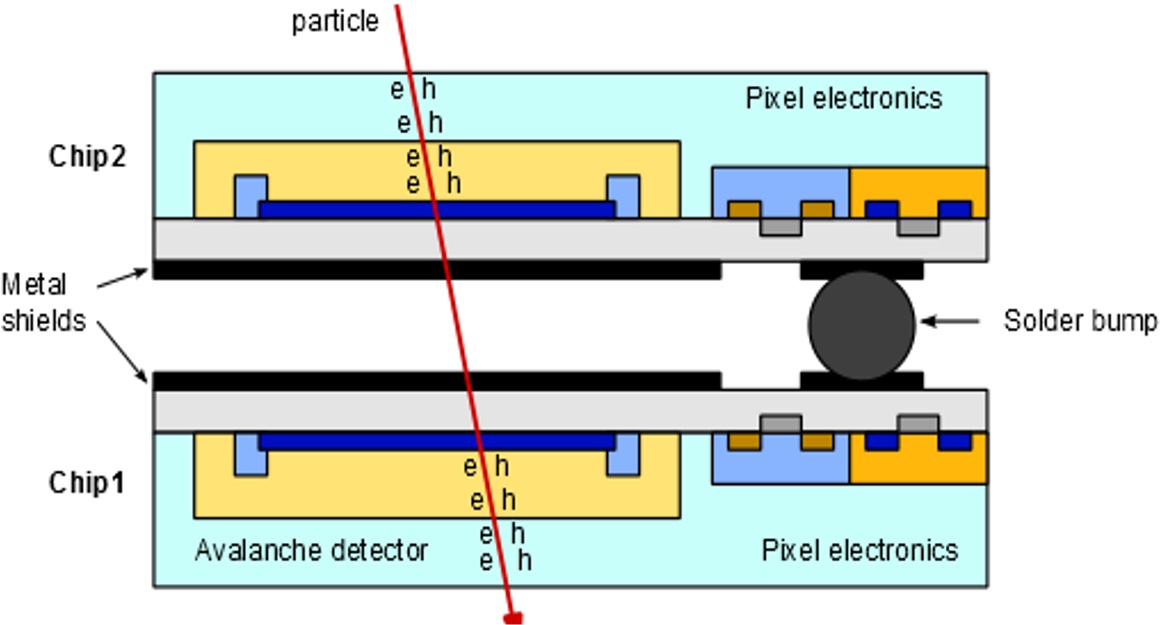- Lodovico Ratti, Paolo Brogi, Gianmaria Collazuol, Gian-Franco Dalla Betta,
Pier Simone Marrocchesi, Lucio Pancheri, Arta Sulay, Gianmarco Torilla, Carla Vacchi
Layered CMOS SPADs for low noise detection of charged particles
Front. Phys., 14 January 2021 | https://doi.org/10.3389/fphy.2020.607319 - P. Brogi, G. Bigongiari, C. Checchia, G. Collazuol, G.F. Dalla Betta, A. Ficorella,
P.S. Marrocchesi, F. Morsani b, M. Musacci, G. Torilla, L. Pancheri, L. Ratti, A. Savoy-Navarro, L. Silvestrin, F. Stolzi, J.E. Suh, A. Sulaj, C. Vacchi, M. Zarghami,
APiX, a two-tier avalanche pixel sensor for digital charged particle detection
- Nucl. Instr. and Meth. A, vol. 958, article 162546, 2020. doi: 10.1016/j.nima.2019.162546
L. Ratti, P. Brogi, G. Collazuol, G.-F. Dalla Betta, A. Ficorella, P. S. Marrocchesi, F.Morsani. L. Pancheri, G. Torilla, C. Vacchi,
DCR Performance in Neutron-Irradiated CMOS SPADs From 150- to 180-nm Technologies.
IEEE Transactions on Nuclear Science, vol. 67, no. 7, pp. 1293-1301, July 2020 - L. Ratti, P. Brogi, G. Collazuol, G.-F. Dalla Betta, A. Ficorella, P.S. Marrocchesi, L. Pancheri, C. Vacchi,
Dark count rate distribution in neutron-irradiated CMOS SPADs
IEEE Trans. El. Dev., vol. 66, no. 12, pp. 5230-5237, Dec. 2019 - M. Musacci, G. Bigongiari, P. Brogi, C. Checchia, G. Collazuol, G.-F. Dalla Betta, A. Ficorella,
P.S. Marrocchesi, S. Mattiazzo, F. Morsani, S. Noli, L. Pancheri, L. Ratti, A. Savoy-Navarro, L. Silvestrin, F. Stolzi, J. Suh, A. Sulaj, C. Vacchi, M. Zarghami,
Radiation tolerance characterization of Geiger-mode CMOS avalanche diodes for a dual-layer particle detector
Nucl. Instrum. Methods, vol. A936, pp. 695-696, 2019.
- L. Ratti, P. Brogi, G. Collazuol, G.-F. Dalla Betta, A. Ficorella, L. Lodola,
P.S. Marrocchesi, S. Mattiazzo, F. Morsani, M. Musacci, L. Pancheri, C. Vacchi
Dark count rate degradation in CMOS SPADs exposed to X-rays and neutrons
IEEE Trans. Nucl. Sci., vol. 66, no. 2, pp. 567-574, 2019
- Ficorella, A., Pancheri, L., Brogi, P., Collazuol, G., Dalla Betta, G., Marrocchesi, P.S., Morsani, F., Ratti, L., Savoy-Navarro, A., Crosstalk Characterization of a Two-tier Pixelated Avalanche Sensor for Charged Particle Detection,
IEEE Journal of Selected Topics in Quantum Electronics, vol. 24, no. 2, pp. 1-8, March-April 2018.
- Pancheri, L., Ficorella, A., Brogi, P., Collazuol, G., Dalla Betta, G.-F.,
Marrocchesi, P.S., Morsani, F., Ratti, L., Savoy-Navarro, A., Sulaj, A.,
First Demonstration of a Two-TierPixelatedAvalancheSensor for Charged ParticleDetection,
IEEE Journal of the Electron Devices Society, 5 (5), art. no. 8008759, pp. 404-410, 2017.
- Pancheri, L., Brogi, P., Collazuol, G., DallaBetta, G.-F., Ficorella, A., Marrocchesi, P.S., Morsani, F., Ratti, L., Savoy-Navarro, A., First prototypes of two-tier avalanche pixel sensors for particle detection,
Nuclear Instruments and Methods in Physics Research, Section A, 845, pp. 143-146, 2017.
- D'Ascenzo N., Marrocchesi P.S., Moon C.S., Morsani F., Ratti.L,, Saveliev V., Savoy Navarro A., Xie Q.
Silicon avalanche pixel sensor for high precision tracking
Journal of Instrumentation, 9-, C03027 (2014)
 |
Development of an Avalanche Pixel Sensor for tracking applications (APiX2) |
|||
| Development of an Intra-Operative Probe for Radio Guided Surgery (ASAP) |
||||
Participating INFN groups: Siena/Pisa, Padova, Pavia, Trento (TIFPA)
Projects: APIX2, ASAP (Array of Silicon Avalanche Pixels))
National coordinator: P. S. Marrocchesi, University of Siena and INFN Pisa
Local coordinators: L. Pancheri (TIFPA), L. Ratti (Pavia), G. Collazuol (Padova), P.Marrocchesi (Pisa/Siena)
The APiX2 project successfully developed an innovative position-sensitive pixelated sensor to detect ionizing particles. The APiX sensor is based on the vertical integration of avalanche pixels connected in pairs and operated in coincidence in fully digital mode with on-chip embedded electronics. The APiX sensor addresses the need to minimize the material budget and related multiple scattering effects in tracking systems requiring a high spatial resolution in the presence of a large occupancy. The new sensor features low noise, low power consumption and suitable radiation tolerance for radiation imaging applications in space experiments, nuclear medicine and industrial controls.
The APiX device provides on-chip digital information on the position of the coordinate of the impinging charged particle and can be seen as the building block of a modular system of pixelated digital arrays, implementing a sparsified readout. As the detector has internal gain (by the avalanche mechanism) the upper layer can be thinned down to a few tens of micron. The largest technological challenge is the vertical integration of the device, under CMOS processes and integration of on-chip electronics. The first two-prototypes were implemented with a micro bump-bonding techique. Further development with TSV based vertical integration is under consideration.
The ASAP projects takes advantage of the real-time imaging capabilities of the new sensor to explore its application in RGS (Radio Guided Surgery). Prototypes of an imaging probe have been built and successfully tested with a beta source. A wireless readout is also being implemented in Pavia.
JOURNAL PAPERS